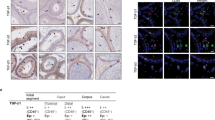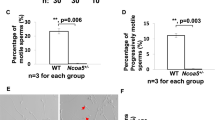Abstract
The mBin1b is a beta-defensin gene identified in the mouse epididymis. In the current report, its expression pattern and antibacterial activities were characterized, and a transgenic (TG) mouse model was developed in which mBin1b was exclusively overexpressed by up to 50-fold over normal levels in the caput epididymis. The experimental animals are healthy with normal reproductive activity, but are more resistant to epididymal infection from Escherichia coli than normal animals. The expression of IL1α and IL1β in the epididymis was decreased in the TG mice, which suggests that mBin1b has a role in the regulation of inflammatory response in the epididymis.
This is a preview of subscription content, access via your institution
Access options
Subscribe to this journal
Receive 6 digital issues and online access to articles
$119.00 per year
only $19.83 per issue
Buy this article
- Purchase on Springer Link
- Instant access to full article PDF
Prices may be subject to local taxes which are calculated during checkout




Similar content being viewed by others
References
Yamaguchi Y, Nagase T, Makita R, Fukuhara S, Tomita T, Tominaga T et al. Identification of multiple novel epididymis-specific beta-defensin isoforms in humans and mice. J Immunol 2002; 169: 2516–2523.
Zhou CX, Zhang YL, Xiao L, Zheng M, Leung KM, Chan MY et al. An epididymis-specific beta-defensin is important for the initiation of sperm maturation. Nat Cell Biol 2004; 6: 458–464.
Patil AA, Cai Y, Sang Y, Blecha F, Zhang G . Cross-species analysis of the mammalian beta-defensin gene family: presence of syntenic gene clusters and preferential expression in the male reproductive tract. Physiol Genomics 2005; 23: 5–17.
Zaballos A, Villares R, Albar JP, Martinez AC, Marquez G . Identification on mouse chromosome 8 of new beta-defensin genes with regionally specific expression in the male reproductive organ. J Biol Chem 2004; 279: 12421–12426.
Yenugu S, Chintalgattu V, Wingard CJ, Radhakrishnan Y, French FS, Hall SH . Identification, cloning and functional characterization of novel beta-defensins in the rat (Rattus norvegicus). Reprod Biol Endocrinol 2006; 4: 7.
Diao H, Guo C, Lin D, Zhang Y . Intein-mediated expression is an effective approach in the study of beta-defensins. Biochem Biophys Res Commun 2007; 357: 840–846.
Bals R, Goldman MJ, Wilson JM . Mouse beta-defensin 1 is a salt-sensitive antimicrobial peptide present in epithelia of the lung and urogenital tract. Infect Immun 1998; 66: 1225–1232.
Lareyre JJ, Thomas TZ, Zheng WL, Kasper S, Ong DE, Orgebin-Crist MC et al. A 5-kilobase pair promoter fragment of the murine epididymal retinoic acid-binding protein gene drives the tissue-specific, cell-specific, and androgen-regulated expression of a foreign gene in the epididymis of transgenic mice. J Biol Chem 1999; 274: 8282–8290.
Pellati D, Mylonakis I, Bertoloni G, Fiore C, Andrisani A, Ambrosini G et al. Genital tract infections and infertility. Eur J Obstet Gynecol Reprod Biol 2008; 140: 3–11.
Cohen LR, Hahn RW . A solution to concerns over public access to scientific data. Science 1999; 285: 535–536.
Dommisch H, Winter J, Willebrand C, Eberhard J, Jepsen S . Immune regulatory functions of human beta-defensin-2 in odontoblast-like cells. Int Endod J 2007; 40: 300–307.
Li P, Chan HC, He B, So SC, Chung YW, Shang Q et al. An antimicrobial peptide gene found in the male reproductive system of rats. Science 2001; 291: 1783–1785.
Zhu CF, Liu Q, Zhang L, Yuan HX, Zhen W, Zhang JS et al. RNase9, an androgen-dependent member of the RNase A family, is specifically expressed in the rat epididymis. Biol Reprod 2007; 76: 63–73.
Fei Z, Chen Z, Wang Z, Fei J . Conditional RNA interference achieved by Oct-1 POU/rtTA fusion protein activator and a modified TRE-mouse U6 promoter. Biochem Biophys Res Commun 2007; 354: 906–912.
Palmiter RD, Brinster RL . Transgenic mice. Cell 1985; 41: 343–345.
Wang HL, Fei ZH, Chen JL, Zhang QX, Xu YH . Adsorption thermodynamics and kinetic investigation of aromatic amphoteric compounds onto different polymeric adsorbents. J Environ Sci (China) 2007; 19: 1298–1304.
Acknowledgements
We thank Dr Orgebin-Christ Marie-Claire for providing a epididymis specific promoter plasmid. The current work was supported by grants from the National High Technology Research and Development Program (2008AA02Z126), National Key Project (2010CB945501), E-Institutes of Shanghai Municipal Education Commission (E03003), Shanghai Natural Science Program (07ZR14082), and Science and Technology Commission of Shanghai Municipality (10140902800, 10DZ2251500). We also thank Dr John Weldon and Jaime Eberle for their English language edition.
Author information
Authors and Affiliations
Corresponding authors
Ethics declarations
Competing interests
The authors declare no conflict of interest.
Additional information
Supplementary Information accompanies the paper on Genes and Immunity website
Supplementary information
Rights and permissions
About this article
Cite this article
Fei, Z., Hu, S., Xiao, L. et al. mBin1b transgenic mice show enhanced resistance to epididymal infection by bacteria challenge. Genes Immun 13, 445–451 (2012). https://doi.org/10.1038/gene.2012.13
Received:
Revised:
Accepted:
Published:
Issue Date:
DOI: https://doi.org/10.1038/gene.2012.13
Keywords
This article is cited by
-
Ablation of the sperm-associated antigen 11A (SPAG11A) protein by active immunization promotes epididymal oncogenesis in the rat
Cell and Tissue Research (2022)



